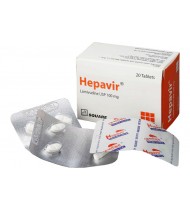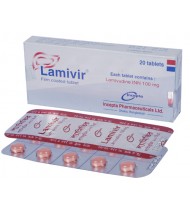Lamivudine [For Chronic Hepatitis B]
Indications
Lamivudine is indicated for the treatment of chronic hepatitis B associated with evidence of hepatitis B viral replication and active liver inflammation.
Pharmacology
Lamivudine is a synthetic nucleoside analogue. Lamivudine is phosphorylated intracellularly to lamivudine triphosphate. Incorporation of the monophosphate form into viral DNA occurs by hepatitis B virus (HBV) polymerase. As a result DNA chain is terminated. Lamivudine triphosphate also inhibits the RNA and DNA-dependent DNA polymerase activities of HIV-1 reverse transcriptase (RT). Lamivudine triphosphate is a very weak inhibitor of mammalian alpha, beta, and gamma-DNA polymerases.
Dosage & Administration
The recommended oral dose of Lamivudine for the treatment of chronic hepatitis B in adults is 100 mg once daily.
Interaction
Trimethoprim 160 mg / Sulfamethoxazole 800 mg once daily has been shown to increase lamivudine exposure (AUC). The effect of higher doses of trimethoprim /sulfamethoxazole on lamivudine pharmacokinetics has not been investigated.
Contraindications
Lamivudine is contraindicated in patients hypersensitive to any of the components of the product.
Side Effects
Several serious adverse events reported with lamivudine (lactic acidosis and severe hepatomegaly with steatosis, post treatment exacerbations of hepatitis B, pancreatitis, and emergence of viral mutants associated with reduced drug susceptibility and diminished treatment response). Malaise, fatigue, fever, ENT infections, sore throat, nausea, vomiting, abdominal discomfort, pain, diarrhea, myalgia, arthralgia, headache, skin rashes may occur. Lactic acidosis and severe hepatomegaly with steatosis, have been reported.
Pregnancy & Lactation
There is no adequate and well-controlled study in pregnant women. Lamivudine should be used during pregnancy only if the potential benefits outweigh the risks. Although it is not known if lamivudine is excreted in human milk, there is the potential for adverse effects from lamivudine in nursing infants. Mothers should be instructed not to breast feed if they are receiving lamivudine.
Precautions & Warnings
Patients should be assessed before beginning treatment and during treatment with lamivudine by a physician experienced in the management of chronic hepatitis B.
Use in Special Populations
It is recommended that doses of Lamivudine should be adjusted in accordance with renal function. Dosage adjustment of Lamivudine in accordance with creatinine clearance is as follows:
- CrCl 50 ml/min: 100 mg once daily
- CrCl 30-49 ml/min: 100 mg first dose, then 50 mg once daily
- CrCl 15-29 ml/min: 100 mg first dose, then 25 mg once daily
- CrCl 5-14 ml/min: 35 mg first dose, then 15 mg once daily
- CrCl <5 ml/min: 35 mg first dose, then 10 mg once daily
Therapeutic Class
Hepatic viral infections (Hepatitis B)
Storage Conditions
Keep below 30°C temperature, away from light & moisture. Keep out of the reach of children.
Hepavir Tablet 100 mg
IndicationsLamivudine is indicated for the treatment of chronic hepatitis B associated with evidence..
25.17Tk.
Lamidin Tablet 100 mg
IndicationsLamivudine is indicated for the treatment of chronic hepatitis B associated with evidence..
25.30Tk.
Lamivir Tablet 100 mg
IndicationsLamivudine is indicated for the treatment of chronic hepatitis B associated with evidence..
25.00Tk.
Showing 1 to 3 of 3 (1 Pages)



